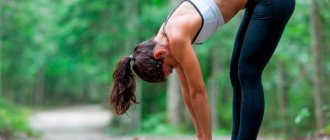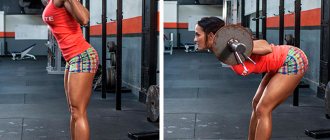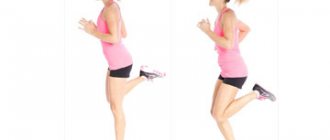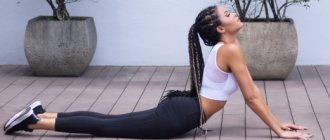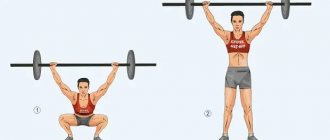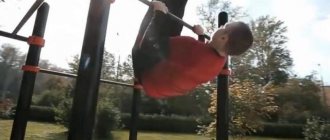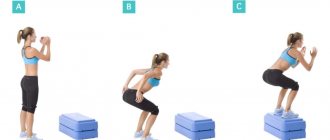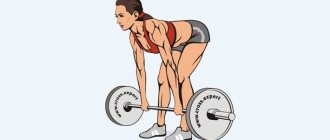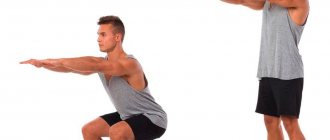Forward bending of the torso is a very simple exercise that has been familiar to us since childhood. Despite its simplicity, it is very useful, as it allows you to tone many important muscles, improves flexibility and has a beneficial effect on health. Although the technique of performing bends is elementary, there are a number of nuances that must be followed when performing them.
Benefits and features of the exercise
Leaning your torso forward is a very natural position for the human body. To perform the exercise you do not need special equipment or physical training. Its simplicity and accessibility allows you to safely include it in home exercise routines . The forward bend exercise affects the body as follows:
- Improves the flexibility of the spine, as well as the mobility of the hip joints, which has a beneficial effect on their health and prevents many troubles.
- Stretching of the hamstring joints, back muscles, buttocks, and abs is trained.
- Bends also improve blood circulation and reduce the risk of vascular diseases in the head.
How not to bend forward
In the video below I showed the correct and incorrect position of the back while performing the front fold.
It is recommended to perform forward bends while sitting on the floor at the end of each strength training session. I wish you successful studies!
Execution technique
Forward bends are a simple exercise, but it's a good idea to learn the proper technique. This will help achieve maximum efficiency and prevent unpleasant consequences.
- You need to stand up straight, place your feet shoulder-width apart, and straighten your back. Maintain a natural arch in your lower back. The chest should be straightened.
- Tighten your abs. Keeping your back straight, lower your body down, rotating at the hip joints. If your flexibility is not good enough to reach the floor with your hands, do not round your back, but slightly bend your knees. Flexibility will develop over time, and you will be able to fully lean forward with straight legs.
- Having reached the bottom point, stay there for a couple of seconds, then return to the starting position, using the muscles of the buttocks. Repeat the exercise as many times as necessary.
While performing the exercise, make sure that the body is not pulled by the back muscles.
This is a technical violation that can be dangerous. The back muscles should support the body in a straight position, and it should be raised by the buttocks. When bending forward from a standing position, watch your breathing. By the way, experts have different opinions regarding this issue. The simplest and safest option is to focus on the anatomical features of the human body. That is, in a standing position, our chest is straightened so that the lungs can accommodate maximum air. At the bottom point everything should be the other way around. Therefore, it is better to lower the body while exhaling, and lift it while inhaling.
If you are a beginner, start doing the exercise in 2-3 sets of 10-15 inclines . It is recommended to perform the exercise smoothly and slowly, without jerking, fully controlling your every movement. It is important to aim to be able to fully bend over from a standing position while keeping your legs straight.
Video lessons
To understand how to correctly perform a particular movement, one text instruction will not be enough. It is also important to observe how this exercise is performed from the side. To reinforce the above material, we invite you to watch the thematic training video.
And the technique of performing forward bends with a barbell in a sitting position can be seen in the video below.
Types of exercise
Having mastered how to bend forward correctly, you can increase the load by using additional weights : a barbell, a barbell, dumbbells.
Another effective variation of the exercise for working the muscles is bending forward from a sitting position. This exercise came to fitness from the world of yoga, where it is known as Paschimottanasana asana. It is also popularly called the “fold.”
This exercise is good to use as a warm-up at the end of a workout. Then its effectiveness will increase, since warmed muscles stretch better. The technique for performing this exercise is as follows:
- You need to sit down on your buttocks and straighten your legs in front of you. Pull your socks out and point them towards you. Press your shins to the floor surface.
- As you exhale, bend forward slightly, keeping your back straight. Use your palms to grab your knees or shins.
- Using your hands, start moving forward. Your task is to stretch the spine behind the crown up and forward. Try not to round your back, otherwise the exercise will not bring any benefit.
- Now relax, as you exhale, press your stomach as close to your legs as possible, as if bending in half. Stretch forward with the top of your head. When performing a forward bend while sitting, you do not need to strain your shoulders and hold your breath. Try to hold this position for 30-60 seconds. With a little practice, you can maintain this position for a couple of minutes.
- You need to get out of this pose correctly. Movements should be slow. Several breathing cycles should come out. Move your lower back slightly back, lift your head and bend slightly towards your chest and back. Slowly rise up, gradually, so that your back is eventually at a right angle to the floor.
Bend forward from a sitting position with legs apart
This option is designed for more experienced athletes who can do classic bends while sitting without any problems.
The exercise is performed as follows:
- Take a sitting position. Spread your arms and legs to the sides. Keep your back straight.
- Tilt your body to the left. Place your left hand back and extend your right hand forward.
- Slowly return to the starting position.
- Tilt your body to the right. Place your right hand back and extend your left hand forward.
- Slowly return to the starting position.
Precautions and contraindications
Bends forward from a standing position, the benefits of which you already know, like all other exercises, have their contraindications. They are associated with two features of this movement: the body in an inverted position and the impact on the spine. undesirable in the following cases:
- Problems with the spine, which involve a ban on tension in the lower back muscles.
- It is also recommended to refrain from bending over if you have headaches, high blood pressure, or vascular diseases of the head.
For problems with the spine, it is often recommended not to bend over from a standing position, but to replace this exercise by lifting the pelvis from a squatting position, in which the arms remain down. Thus, the position in which the torso is parallel to the floor is excluded - it is in this position that the lower back muscles are maximally tense.
When performing a strength exercise, bending your torso forward, avoid common mistakes. These include lifting the heels off the floor, as well as unlocking the fingers if they are in the “lock”. Bending the body while sitting also has a number of contraindications. These include the following:
- displacement of intervertebral discs;
- radiculitis, arthritis;
- exacerbation of respiratory diseases, in particular seasonal allergies;
- severe pain in the lower back;
- pregnancy.
Bends from a sitting position, like other exercises originally from yoga , also involve a number of nuances. These include the following:
- Before you begin to stretch, slide your heels forward along the floor. This will allow you to move your buttocks back, which will allow your body to take a more comfortable position.
- Breathe as deeply and comfortably as possible. Try to maintain concentrated tension in your legs, and relax your shoulders and arms in time.
- To properly stretch your spine, try to rotate your hips inward and spread your buttocks in different directions.
- Bends are performed correctly if you seem to curl up in the area of the hip joints. This way you can test yourself.
- Do not turn your feet with the soles of your feet inward.
- Don't rush or make sudden movements. Not everyone can immediately reach their forehead to their knees. Keep your back straight throughout the exercise.
- Try not to help yourself too much with your hands, as this increases the risk of lower back injury. It is also important not to bend your knees.
Bend forward from a sitting position: standard
The exercise discussed in the article is of interest not only to people who regularly play sports, but also to schoolchildren and students who need to take it in physical education. How do you pass the standard for sitting forward bends? What details should you pay attention to when performing this exercise? What mistakes should you not make when passing the standard? We will now try to figure this out.
To evaluate the result, a special measuring ruler is used. Its middle is taken as “0” (zero). On one side of the center, o is marked every centimeter, and on the other - with the sign “-“. While in a sitting position on the side of Fr. If during the exercise a participant bends his legs at the knee joint, his result will not be counted. The final result is recorded according to the mark that the student reaches with the tips of the closed middle fingers: with a minus sign if he did not reach the zero value of the scale, with a plus sign if he exceeded this zero value. Measurement accuracy – 1 cm.
Analysis of the exercise
What muscles work
1. Ideally, the main muscles are the gluteus maximus and medius, the hamstrings and long back muscles. How stabilizers work the abdominal muscles
2. Auxiliary – semimembranosus, semitendinosus, as well as gastrocnemius and flexor digitorum longus.
pros
· Does not place a large axial load on the spine;
· Increases flexibility;
· Improves the elasticity of the muscles of the back of the thigh;
· Relaxes after strength training, relieves congestion, and can be an excellent option for active recovery;
· Helps increase abdominal muscle tone;
Helps you gain the necessary sensorimotor skills to perform Romanian deadlifts, stiff legged deadlifts and classic deadlifts;
· Is a preparatory movement for classical good morninging;
· Improves mobility of the hip joint.
Minuses
· Not suitable for athletes with poor flexibility
· Preparation
· The exercise requires a well-warmed body and decent mobility in the joints. It must be performed after a general warm-up. As a special exercise, knee lifts to the chest are done, as well as shallow bends.
· Those who perform the movement itself as a preparatory exercise for deadlifts should still do a general warm-up and a set of leg raises at the beginning of the workout to increase amplitude.
· You can also do a couple of warm-up approaches with incomplete amplitude.
Proper execution
· The feet should be either the width of the pelvic bones, or slightly wider or narrower, but there should be no discomfort when working in the hip joints;
· Legs remain straight during movement and do not bend at the knees;
· The back can be slightly rounded in the thoracic region, if this is a person’s natural posture, but bending the lumbar region upward in a “dome” is prohibited, as in all types of deadlifts.
Errors
· Performing a classic deadlift, that is, pushing off the floor with bending the knees;
· Tilt to one side, that is, touching the floor with one hand due to contraction of the oblique abdominal muscles on one side;
· Work with the lower back, tension in this area during lifting;
· Chaotic breathing during exercise or holding it;
· There is no fixation, that is, the movement is not performed to the maximum amplitude and always to a different depth.
Efficiency Tips
1. You need to stay for some time at the lower point of the amplitude, performing the exercise as efficiently as possible;
2. Do not push the body into the working amplitude too actively, move smoothly, work to gradually deepen the amplitude;
3. Use stands only when there is a lack of amplitude and you need to deepen it, do not force this process;
4. If the goal is to strengthen muscles, perform an exercise with weights, move on to Romanian deadlifts and straight-legged deadlifts;
5. Beginners can make the movement more difficult by extending their arms behind their back, or clasping them behind their back;
6. Alternate this exercise with a seated variation, which is used to improve amplitude in the hip joints;
7. You can do the exercise with support on one leg, and the other slightly back. This way you can work your hamstrings more;
8. To increase the load on the muscles of the buttocks and thighs, you should alternate this exercise with the King deadlift.
Inclusion in the program
The exercise is included in the program of those who perform strength training as a warm-up. It is done at the beginning of training for 5-10 repetitions to stretch the muscles and increase mobility in the joints. But this is not always the rule. Beginners can do the exercise as an independent strength exercise. Continuing exercises - as an exercise for a more “detailed” warm-up, if required.
Content
- 1 Forward bend (exercise) 1.1 Forward bend
- 1.2 Bend forward with diagonal legs
- 1.3 Bend forward on one leg
- 1.4 Jump in place
- 1.5 Jump in place with diagonal legs
- 2.1 Bent over squat
Execution options
·
Bends from a sitting position . You need to sit on a gymnastics bench or bench for bench press. Bends forward, exhaling with effort, that is, while standing up. This is a very specific variation, it is used in sports as a way to increase mobility in the hip joints;
· Tilts in depth . This is an option while standing on a stand; it is suitable for those who have enough amplitude and who can actually bend below the level of their feet so as not to bend their back completely.
